Revised: 12-Apr-2013
In 1981 I traveled to several cities in the United States and gave a talk entitled “Remez: Hinting at Scripture.”[1] As part of that talk, I said something similar to the following:
One of the basic, Jewish techniques of teaching in the time of Jesus involved the use of רֶמֶז (remez), which is the Hebrew word for “hint” or “allusion.” Jewish teachers, instead of fully quoting verses of Scripture, commonly alluded to the passages upon which their lessons were based. By using the remez technique, a teacher conveyed a great deal of information with remarkable brevity, in much the same way a poet can express complex ideas through metaphors.
The rabbis could teach in this manner because most Jews of the period—and certainly all disciples of sages—were well-versed in the Torah, the Prophets and the Writings. The substance of an allusion sometimes was found in a passage immediately before or after the verse at which the teacher had hinted. To quote the entire passage was unnecessary since most in the audience had learned large segments of Scripture by rote. The moment a teacher made an allusion, the whole passage flashed across the mind’s eye of the biblically literate listener.
One finds numerous examples of remez in the Gospels. Many Christians, however, lack the scriptural background such a technique assumes. As a result, they run the risk of missing the subtler aspects of Jesus’ teachings.
John the Baptist used remez when he asked Jesus, “Are you the coming [one]?” (Luke 7:20; Matt 11:3). John hinted at “The Coming One” of Malachi 3:1 and Zechariah 9:9. Jesus responded in like manner: “The blind receive their sight, the lame walk, lepers are cleansed, the deaf hear, the dead are brought back to life and the poor have the good news preached to them.” Jesus’ answer contained hints at Isaiah 29:18, 35:5-6, 42:7 and 61:1. The allusions John and Jesus made were not solely for economy of words. The hinting constituted a sophisticated way of commenting upon Scripture….[2]
Paid Content
Premium Members and Friends of JP must be logged in to access this content: Login
If you do not have a paid subscription, please consider registering as a Premium Member starting at $10/month (paid monthly) or only $5/month (paid annually): Register
One Time Purchase Rather Than Membership
Rather than purchasing a membership subscription, you may purchase access to this single page for $1.99 USD. To purchase access we strongly encourage users to first register for a free account with JP (Register), which will make the process of accessing your purchase much simpler. Once you have registered you may login and purchase access to this page at this link:

- [1] “Remez: Hinting at Scripture” was one of the lectures delivered as part of a seminar that I conducted in several U.S. cities in 1981. Two years later I co-authored Understanding the Difficult Words of Jesus. This book contains no reference to remez. I included the “remez” lecture on one of the audio cassettes in the “Reading the Gospels Hebraically” teaching series. ↩
- [2] I repeated this lecture during the speaking tour, both before and after it was recorded. As I developed the presentation, I adapted the wording. Nevertheless, its essence remained identical to this quotation. ↩































































































